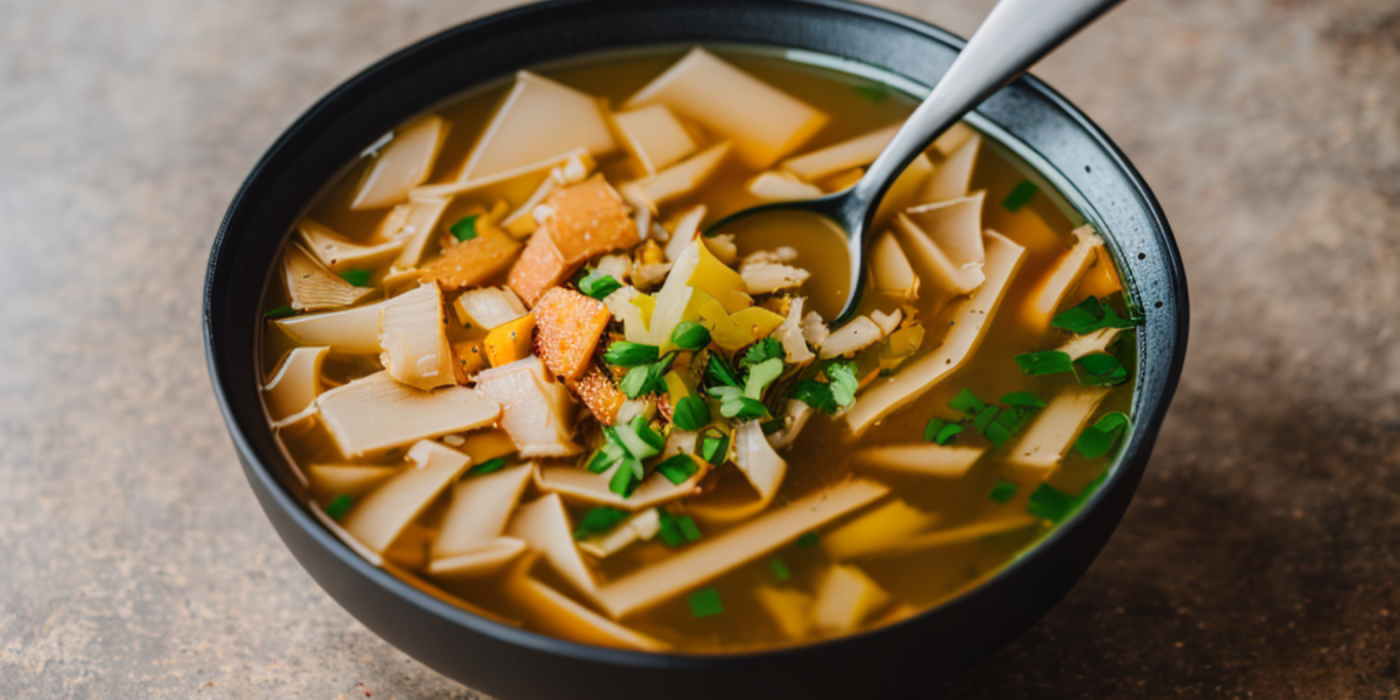Dashi Decoded: Nutritional Values, Health Benefits, and Your Authentic Recipe Guide

Unfolding before us is a culinary journey that will take us to the heart of Japanese cuisine. Our focus is dashi, a traditional broth that serves as the cornerstone for many beloved dishes in Japan. Yet, dashi is more than just a tasty broth - it's also a veritable goldmine of nutrients that provide numerous health benefits. This article will delve into the nutritional composition of dashi, explore its health benefits, and guide you in crafting this delectable broth at home.
What Lies Ahead?
Understanding Dashi
First, we'll explore the landscape of what dashi is, its essential role in Japanese cuisine, and the various types you may encounter. From konbu dashi to katsuo dashi and beyond, we'll navigate through this wonderful assortment of traditional broths.
Unpacking the Nutrients
We'll then take a scientific look at what makes dashi a nutritious choice. Delving into a detailed analysis of the nutrients, vitamins, and minerals in dashi, we will explore how these contribute to a balanced and healthy diet.
Benefits to Your Health
Next, we'll unpack the myriad health benefits offered by this humble broth. Backed by scientific studies, you'll gain insights into how regular consumption of dashi could potentially enhance your health and wellbeing.
Bringing Dashi Home
Last, but certainly not least, we'll equip you with a step-by-step guide to making traditional dashi in your own kitchen. With this skill under your belt, you'll be able to bring a touch of authentic Japanese flavour to your everyday meals.
We're excited to embark on this dashi adventure with you. Let's dive in!
Diving into the World of Dashi
Understanding Dashi
At its core, dashi is a soup and cooking stock that is quintessential to Japanese cuisine. It forms the backbone of many dishes in Japan, from soups to stews, and even noodles. This unique broth is adored for its umami-packed flavour, achieved by using simple, high-quality ingredients.
Varieties of Dashi
There's a stunning variety when it comes to types of dashi, each with its distinct taste and character. The most common form is 'Ichiban Dashi,' often utilised in clear soups and delicate dishes. This is made using kombu, a type of kelp, and katsuobushi, dried bonito flakes.
On the other hand, 'Niban Dashi' uses the leftover ingredients from Ichiban Dashi and is ideal for stronger flavoured dishes. Variations also include 'Kombu Dashi,' purely plant-based and perfect for vegetarians, 'Shiitake Dashi' made from dried shiitake mushrooms, and 'Iriko Dashi,' prepared with dried sardines.
The Traditional Dashi Making Process
Creating dashi at home traditionally involves a precise and respectful process, almost a ritual. In making Ichiban Dashi, for example, kombu is first gently simmered, then removed just before the water boils. Katsuobushi is then added to the simmering water and the heat turned off. After a few minutes of steeping, the bonito flakes are strained out, leaving behind a clear, flavourful broth.
Understanding the variety and preparation techniques of dashi gives us an appreciation for the subtleties of Japanese cuisine and prepares us for the nutritious voyage we're about to embark on.
Delving into the nutritional fabric of dashi, we find that this humble broth holds an impressive array of vitamins, minerals, and other vital nutrients. Let's dissect these components further.
Nutritional Profile of Dashi
The primary ingredients in dashi, such as kelp and bonito, are replete with a variety of essential nutrients. Kelp is a potent source of iodine, a critical mineral for healthy thyroid function. Additionally, it supplies other minerals like potassium, calcium, and magnesium, as well as vitamins A, C, E, and K.
Bonito flakes, made from dried and fermented skipjack tuna, offer a healthy dose of protein, alongside essential omega-3 fatty acids. Notably, these flakes are also high in Vitamin B12, necessary for nerve function and the production of red blood cells.
Health Benefits of Dashi's Nutrients
The nutrients found in dashi contribute to a multitude of health benefits. For instance, iodine from kelp aids in maintaining a healthy metabolism, while the calcium supports bone health. Omega-3 fatty acids from bonito have been linked to improved heart health, reduced inflammation, and enhanced brain function.
Dashi Versus Other Broths
Compared to other similar broths, dashi stands out in its simplicity and nutrient-density. Unlike heavier broths which can be high in sodium and fat, dashi provides a light, yet flavourful base with a unique umami character, and it's often lower in calories. The iodine content in dashi, thanks to the kelp, is also higher than in many other broths. Thus, dashi not only delights the palate but also offers an excellent nutritional profile.
Reaping the Health Benefits of Dashi
A Bounty of Health Benefits
Dashi isn't just a cornerstone of Japanese cuisine, it's also packed full of health-boosting properties. It's a low-calorie broth that packs a nutritious punch. The Iodine found in the Kombu seaweed used in dashi is essential for healthy thyroid function. Moreover, the bonito flakes used are a rich source of protein and Omega-3 fatty acids, which contribute to heart health.
It's also worth noting that dashi is rich in umami – the 'fifth taste'. This savoury taste, provided by glutamic acid, enhances satiety, potentially aiding in weight management.
Scientific Backing
The health benefits of dashi aren't just culinary hearsay – they're backed by robust scientific research. Several studies have indicated that a regular intake of dashi can help maintain cardiovascular health, thanks to its richness in Omega-3 fatty acids.
Research also points to the potential of dashi in managing and preventing age-related diseases. The Glutamate content in dashi has shown promising results in cognitive health, potentially mitigating risks associated with neurodegenerative diseases.
Recommended Daily Intake
When it comes to the recommended daily intake of dashi, there's no hard-and-fast rule. It can vary depending on individual dietary needs. However, incorporating dashi into your regular meals – for instance, as a base for soups, or a seasoning for dishes – can be a beneficial addition to a balanced diet. As always, if you have any specific dietary concerns, it's best to consult a healthcare professional.
Embarking on Your Homemade Dashi Journey
Traditional Dashi at Home: A Step-by-step Guide
Let's walk through the simple, yet rewarding process of creating traditional dashi at home.
- First, soak a 10cm piece of kombu kelp in 4 cups of water for about 30 minutes.
- Next, slowly bring the water to a simmer, making sure not to let it boil.
- Once simmering, remove the kombu kelp to prevent any bitterness.
- To the pot, add 1 cup of bonito flakes and let it simmer for about a minute.
- Finally, strain the broth through a sieve to collect your homemade dashi.
Tips for the Budding Dashi Maker
Dashi making, like any other culinary craft, requires patience and attention to detail. If you're new to making dashi, here are a few tips:
- Make sure not to overcook the bonito flakes, as it may lead to a bitter taste.
- You can adjust the amount of bonito flakes and kombu kelp based on your personal taste preference.
- Use your homemade dashi immediately, or store it in a fridge for up to a week.
Safety First: Precautions to Keep in Mind
While making dashi is generally straightforward, always remember basic kitchen safety. Keep an eye on the simmering broth to prevent it from boiling over. Also, when straining the hot dashi, be sure to handle the sieve and pot with care to avoid any burns.
Now, you're all set to create your own dashi at home. Happy brewing!
Concluding Our Dashi Discovery
Revisiting Dashi Delights
We have now journeyed through the enchanting world of dashi, exploring its deep-rooted significance in Japanese cuisine and the array of types to choose from. Delving deeper, we unravelled the complex tapestry of nutrients, vitamins, and minerals contained within this unassuming broth and held a mirror to the myriad health benefits these components confer. This thorough comparison of dashi with other broths highlighted its unique nutritional standing, adding further substance to its claim of being one of Japan's cornerstone flavours.
Your Turn to Brew the Broth
In light of these insights, the appeal of introducing dashi into your daily diet becomes compellingly clear. As a delightful bonus, we also imparted the secrets of brewing a traditional dashi right in your kitchen. Whether you're a seasoned culinary artist or a novice food enthusiast, dashi is a recipe that's as rewarding to make as it is to savour.
The Dashi Dialogue
We now pass the baton to you, dear reader. Have you ever experimented with dashi in your meals? What have been your experiences and observations? Did you perceive any health benefits upon integrating it into your diet? We'd love to hear your stories and insights. Do share them in the comments below. Together, let's continue the dashi dialogue, and further enrich this wonderfully immersive culinary adventure!
Related to this article are the following:
I do hope you have enjoyed this article and hope that you will subscribe to my newsletter so you can get the latest information about all things naturally relaxing.
Stay in touch, join the Naturally Relaxing Newsletter
Newsletter Signup
Post Your Comments
or post as a guest
Be the first to comment.
Latest articles in Food

Hot Cross Buns This Easter: A Timeless Tradition of Baking and Sharing

Chocolate Krispie Cakes for Easter: A Simple, Festive Treat for All

2023 Christmas Culinary Delights: Recipes for the Ultimate Festive Feast

Embrace Autumn with the Best Pumpkin Spice Recipes in the UK

Turning Pumpkin Carvings into Pumpkin Pie: A British Culinary Tradition






